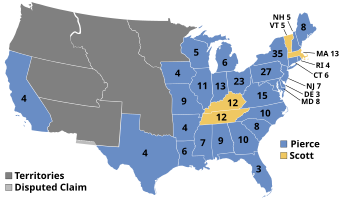U.S. presidential election, 1852
|
|
|||||||||||||||||||||||||||||
|---|---|---|---|---|---|---|---|---|---|---|---|---|---|---|---|---|---|---|---|---|---|---|---|---|---|---|---|---|---|
|
|||||||||||||||||||||||||||||
|
All 296 electoral votes of the Electoral College 149 electoral votes needed to win |
|||||||||||||||||||||||||||||
| Turnout | 69.6% |
||||||||||||||||||||||||||||
|
|||||||||||||||||||||||||||||
|
Presidential election results map. Blue denotes states won by Pierce/King, buff denotes those won by Scott/Graham. Numbers indicate the number of electoral votes allotted to each state.
|
|||||||||||||||||||||||||||||
|
|||||||||||||||||||||||||||||
The United States presidential election of 1852 was the seventeenth quadrennial presidential election, held on Tuesday, November 2, 1852. It bore important similarities to the election of 1844. Once again, the incumbent president was a Whig who had succeeded to the presidency upon the death of his war-hero predecessor. In this case, it was Millard Fillmore who followed General Zachary Taylor. The Whig party passed over the incumbent for nomination, casting aside Fillmore in favor of General Winfield Scott. The Democrats nominated a “dark horse” candidate, this time Franklin Pierce. The Whigs again campaigned on the obscurity of the Democratic candidate, and again, the strategy failed.
Pierce and his running mate William R. King went on to win what was at the time one of the nation’s largest electoral victories, defeating Scott and his running mate, William Alexander Graham of North Carolina, 254 electoral votes to 42. In the aftermath of this overwhelming defeat the Whig Party rapidly collapsed as a national political force as internal tensions regarding the issue of slavery caused mass abandonment of the party, resulting in the party’s failure to nominate a candidate for President in 1856, making 1852 the last presidential election in which the Whig Party participated.
Pierce’s substantial margin of victory did not signal the dawn of a new era of political dominance for the Democrats. The Whigs were soon replaced as the Democratic Party’s primary opposition by the new Republican Party, which became the dominant force in American Presidential politics for decades to come after the late 1850s. No presidential candidate from the Democratic party would again win a majority in both the popular and electoral vote until 1932, when Franklin D. Roosevelt defeated Republican Herbert Hoover. Pierce himself would prove to be a largely ineffectual President and was denied his own party’s nomination in 1856 in favor of James Buchanan (who would also serve just one term in office).
...
Wikipedia




